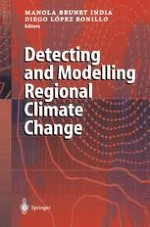2001 | OriginalPaper | Buchkapitel
North Atlantic Oscillation Projection on Romanian Climate Fluctuations in the Cold Season
verfasst von : Roxana Bojariu, Daniela-Mihaela Paliu
Erschienen in: Detecting and Modelling Regional Climate Change
Verlag: Springer Berlin Heidelberg
Enthalten in: Professional Book Archive
Aktivieren Sie unsere intelligente Suche, um passende Fachinhalte oder Patente zu finden.
Wählen Sie Textabschnitte aus um mit Künstlicher Intelligenz passenden Patente zu finden. powered by
Markieren Sie Textabschnitte, um KI-gestützt weitere passende Inhalte zu finden. powered by
The North Atlantic Oscillation (NAO) is one of the most important modes of large scale variability in the Northern Hemisphere. In this study a more detailed regional projection of NAO related climate fluctuations over the Romanian territory is investigated. Monthly air surface temperature and precipitation anomalies from 62 Romanian stations and NCEP reanalysis data have been analysed to identify the local response to the NAO influences for the periods 1961–1990, and 1961–1999, respectively. The winter responses to the large scale circulation over the Romanian regions configure patterns of positive (negative) thermal anomalies, and negative (positive) precipitation anomalies associated with a high (low) NAO index. The winter NAO related signal is stronger in the extra-Carpathian regions, due to the orographic effects imposed on the atmospheric flow by the Carpathian mountains. NAO related behaviour is revealed by a lagged correlation between temperature anomalies in January and the following November and between temperature anomalies in November and the following January over the Romanian regions. Furthermore, a source of NAO related predictability has been identified over Central and Eastern European regions. November thermal anomalies over these regions are negatively correlated with the NAO index and could be used to predict the onset of the NAO phase in the following winter.
